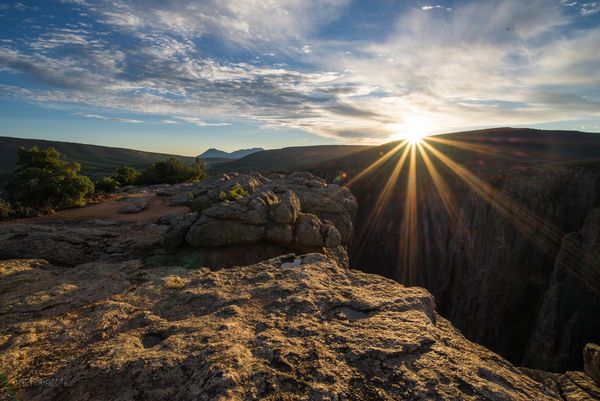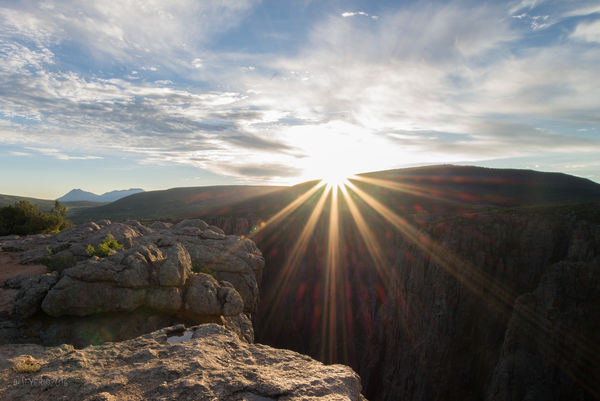Sensor Photosites Showing Up--Can It Be Avoided or Overcome?
Aug 4, 2016 12:43:52 #
I was so disappointed when I got to the images of the sunrise from my last trip and saw this mess. I've shot many sunburst but had not experienced what appears to be the sensor photosite array revealed as red dots across the rays. I am familiar with solar flare caused by reflections bouncing around between glasses or caused by dust particles on the lens, but this is a different animal to me. Is there anything I can do to avoid this in future? Other than turning the red saturation all the way down in LR to minimize the spots, I don't know any way to correct it. Is this related to the lens? Does stopping down make any difference--I was at f/22 for the sunburst, which is recommended.
Aug 4, 2016 12:49:59 #
Nothing looks abnormal to me. It looks just like lens flare. Perhaps you could circle an area in which you have concern. Additionally, did you have any filters attached to the lens at the time?
--Bob
--Bob
dmeyer wrote:
I was so disappointed when I got to the images of ... (show quote)
Aug 4, 2016 13:01:29 #
dmeyer wrote:
I was so disappointed when I got to the images of ... (show quote)
I have to ask what lens you were using?
I have seen this phenomenon often when using older film lenses on digital cameras because the film lenses did not have the anti-reflective coatings on their rear elements like digital lenses do. This can cause reflections from the shiny sensor to reflect back onto that rear lens element and in turn bounce back to the sensor to be captured in the image. This is only an issue when shooting these old lenses directly into a bright light source such as you are doing here. Nothing can be done to eliminate the problem in the way of filters or processing short of cloning out each and every little spot that bothers you.
Aug 4, 2016 13:46:31 #
wdross
Loc: Castle Rock, Colorado
dmeyer wrote:
I was so disappointed when I got to the images of ... (show quote)
There is some well defined lense flare at about 8 o'clock from the sun. But from my experiences, the other "red dots" are being caused by very fine residual dust and the diffraction and reflections resulting from such. This is why it seems more randomly distributed through the rays and even more lighter versions of them between the rays. Unless one puts on an actual sunburst filter, even the sunburst in the picture is caused by the edges of the lense diaphragm, especially at f22. Personnally, I like the effect and have never worried about it since I feel it adds a bit of magical feel to the sunrise. And, other than having an extremely clean lense, I don't believe there is really any other remedy for the "problem".
Aug 4, 2016 17:16:27 #
rmalarz wrote:
Nothing looks abnormal to me. It looks just like lens flare. Perhaps you could circle an area in which you have concern. Additionally, did you have any filters attached to the lens at the time?
--Bob
--Bob
Bob, did you view the download? I didn't use any filter for the morning shoot. But, if you can zoom in on the download, you'll see a specific dot pattern across the entire sunburst. I de-saturated the red to minimize it but it looks pretty yucky to me. There is some lens flare off to the left side only. I may have to post another image zoomed in on the sunburst only.
Aug 4, 2016 17:22:07 #
MT Shooter wrote:
I have to ask what lens you were using? br I have ... (show quote)
The Nikon 18-35mm f/3.5-4.5 is the 2013 issue, so I think it has all the current lens coatings. But I do think what you suggest about the sensor being reflected against the back of the lens glass is what I am seeing. I did not see that on the 24-85mm lens I used at Bryce Canyon. Any idea whether there is a degree off center where the issue goes away? I was composing with the sun in the upper third.
Aug 4, 2016 17:28:03 #
wdross wrote:
There is some well defined lense flare at about 8 ... (show quote)
Yes, at 8 o'clock there is true lens flare. But the lens was cleaned with brush and lenspen prior to shooting since I know how readily dust particles can ruin an image shot into the sun. Which isn't to say a stray particle didn't hitch a ride, but not to the extent that I am seeing a pattern. Did you view the download? There is some solace in hearing that the red dots aren't necessarily a dreadful thing to view!

Aug 4, 2016 17:29:59 #
dmeyer wrote:
The Nikon 18-35mm f/3.5-4.5 is the 2013 issue, so I think it has all the current lens coatings. But I do think what you suggest about the sensor being reflected against the back of the lens glass is what I am seeing. I did not see that on the 24-85mm lens I used at Bryce Canyon. Any idea whether there is a degree off center where the issue goes away? I was composing with the sun in the upper third.
I cannot say if it would go away or not, just that I have seen it before and I am pretty sure that's what you have.
The sun sets every day, I would set up and take several shots into it with the sun at different positions as an experiment to see if the phenomenon changes with the suns position. My personal expectation is that so long as the sun is in the middle half of the sensor area (DX crop portion), the issue will likely remain.
Let us know what happens.
Aug 5, 2016 04:02:52 #
MT Shooter wrote:
I cannot say if it would go away or not, just that I have seen it before and I am pretty sure that's what you have.
The sun sets every day, I would set up and take several shots into it with the sun at different positions as an experiment to see if the phenomenon changes with the suns position. My personal expectation is that so long as the sun is in the middle half of the sensor area (DX crop portion), the issue will likely remain.
Let us know what happens.
The sun sets every day, I would set up and take several shots into it with the sun at different positions as an experiment to see if the phenomenon changes with the suns position. My personal expectation is that so long as the sun is in the middle half of the sensor area (DX crop portion), the issue will likely remain.
Let us know what happens.
I'll do the experiment with shooting the sun in different positions in the frame and see if there's a sweet spot for this lens...or use the 24-85mm instead.

Thanks for helping me understand what I am dealing with, MT Shooter.
Aug 5, 2016 06:52:39 #
wdross
Loc: Castle Rock, Colorado
dmeyer wrote:
Yes, at 8 o'clock there is true lens flare. But the lens was cleaned with brush and lenspen prior to shooting since I know how readily dust particles can ruin an image shot into the sun. Which isn't to say a stray particle didn't hitch a ride, but not to the extent that I am seeing a pattern. Did you view the download? There is some solace in hearing that the red dots aren't necessarily a dreadful thing to view! 

Yes, I did view the download. I know you have kept your lense as clean as possible, but there are still some sources, controllable and uncontrollable, for these particles. Front and back side of both the filter and the lense and the lense's internal surfaces. As some UHHs in other threads have mention, as a zoom lense changes length, the pressure difference is compensated for by allowing air into the lense. I also believe that MT Shooter is correct in that the sun angle and position will also affect the degree to which these happen. I also noticed that the contrast level where these are most prominently occurring is high contrast. I am fairly certain this effect stretches the same distance around the sun but is hidden more in the light sky. And I believe the red shift is due to the early morning sky (more red light than at noon). And as MT Shooter and I have indicated, these exist but are not always controllable.
Aug 5, 2016 07:02:39 #
I don't think it's a sensor problem. Shooting directly at the sun can produce strange results - not too good for the eyes, either. Experiment and see if you can find a way to avoid those barely noticeable spots.
Aug 5, 2016 08:19:39 #
dmeyer wrote:
I was so disappointed when I got to the images of ... (show quote)
Stunning shot!
Lens flare is a pain to deal with, and this is what it looks like to me.
There are many ways to fix this in post. This is a write up I did a few years ago that might help:
http://pixeldiarist.blogspot.com/2012/03/dreaded-lens-flare-no-biggie.html
Aug 5, 2016 09:00:01 #
dmeyer wrote:
I was so disappointed when I got to the images of ... (show quote)
Considering the image's prominent splitting of the sunlight into a pattern of beams (which we should probably regard as a photographic artifact), the peppering of red spots within the flare pattern might as well be regarded as normal (which does not imply the same would be seen in a slightly different take). The little special group of spots at the 8-o'clock position could be removed to advantage.
Aug 5, 2016 10:14:49 #
I am not a fan of noise reduction, but a gentle application of chromatic noise reduction might soften those red spots.
Aug 5, 2016 12:30:49 #
wdross wrote:
Yes, I did view the download. I know you have kept... (show quote)
I went back and cropped the sunburst to enlarge so that the red dots would be more apparent. You'll be better able to see the pattern (sensor) as opposed to randomness (dust). Hope it helps to clarify what I'm seeing. It may be that I'll have to use a different lens for sun shots to reduce the effects of this phenomenon.
If you want to reply, then register here. Registration is free and your account is created instantly, so you can post right away.





